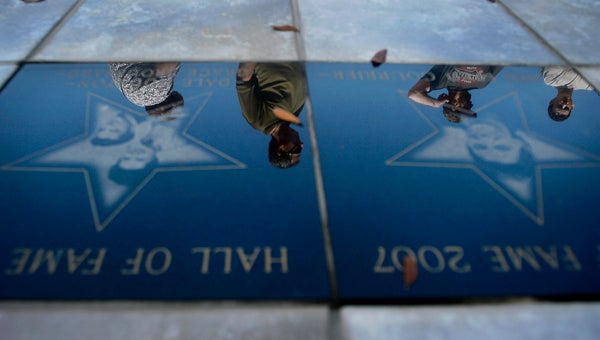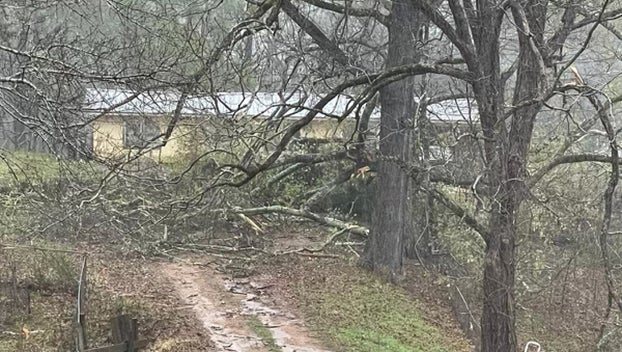Rain-packed Tropical Storm Lee forms off Louisiana
Published 2:06 pm Friday, September 2, 2011
NEW ORLEANS (AP) — Tropical Storm Lee formed in the waters off Louisiana on Friday, threatening a drenching along much of the Gulf coast over the Labor Day weekend with up to 20 inches of rain in some spots.
Mississippi’s governor declared a state of emergency in seven counties on or near the coast, saying the storm is expected to cause tremendous flooding. A state of emergency frees up resources that can be used to prepare for a storm, and Louisiana’s governor declared one Thursday because of the threat of flash flooding.
Lee could unleash “efficient and torrential topical rains” for the next several days, the National Weather Service said.
In the French Quarter, some tourists were caught off guard by the storm as it rained off and on. Kyla Holley of Madison, Wis. and her husband, Rob, were in for the Labor Day weekend holiday.
“I didn’t even know about it,” Kyla Holley said. “But it wouldn’t have stopped us from coming.”
Tropical storm warnings were in effect from Mississippi to Texas, including New Orleans, and flash flood warnings extended along the Alabama coast into the Florida Panhandle. The National Hurricane Center said the system will dump 10 to 15 inches of rain over southern areas of Louisiana, Mississippi and Alabama through Sunday and as much as 20 inches in some spots.
The storm also has cut off nearly half the normal oil production from the Gulf of Mexico’s U.S. waters. The federal Bureau of Ocean Energy Management, Regulation and Enforcement said Friday that 169 of the 617 manned production platforms in the Gulf have been evacuated, along with 16 of the 62 drilling rigs now operating in the Gulf. The evacuations have resulted in the shut-off of 47.6 percent of the Gulf’s daily normal oil production and 33 percent of the normal daily natural gas production.
The water-logged storm is tantalizingly close to Texas but still too far away to alleviate the state’s worst drought since the 1950s. If the center moves mostly into Louisiana, as expected, winds on its west side will blow from land to open water and reduce the chance of rain in Texas, NWS meteorologist Dennis Cavanaugh in Fort Worth said. The hot, dry winds could spur fire danger across the state.
In Alabama, Gov. Robert Bentley didn’t declare an emergency but ordered state agencies to be ready to respond if needed.
Morning skies were overcast with spotty rain on the Alabama coast Friday morning, but workers were still putting boats in the water for the Labor Day weekend at Sportsman Marina in Orange Beach, Ala.
“A lot of people go into a panic, but it’s mainly just going to be a rainmaker,” marina manager Ricky Garrett said. “We’re really not taking any precautions. They’re talking 5 to 15 inches of rain over a five-day period depending on who you listen to.”
Lee is the 12th named storm of the Atlantic hurricane season.
The National Hurricane Center said the center of Lee was about 200 miles (320 km) southeast of Cameron, La., on Friday and moving northwest at just 2 mph (4 kph). Its center was expected to make landfall in Louisiana over the weekend.
“Wow. This could be a very heavy, prolific rainmaker,” National Weather Service meteorologist Frank Revitte said.
As hurricane season is hitting its peak in the Atlantic, storm watchers were monitoring three disturbances. Besides the Gulf depression, Katia was spinning in open waters. It regained hurricane strength Friday after weakening the day before and forecasters said it would continue to grow stronger.
Katia was about 705 miles east of the Leeward Islands and moving west-northwest at 14 mph with maximum sustained winds Friday of 75 mph, making it a Category 1 hurricane.
The hurricane center said it was too early to tell if Katia will hit the U.S. but that it is expected to pass north of the Caribbean.
There was also a slow-moving low pressure system about 450 miles south of Halifax, Nova Scotia, that had a 60 percent chance Friday of becoming a tropical cyclone in the next two days.
They all come on the heels of Hurricane Irene, which brought destruction from North Carolina to New England late last month.
In Louisiana, Gov. Bobby Jindal said he was concerned about the serious threat of flash flooding in his state, leading to his emergency action. After devastating Hurricane Katrina in 2005, nothing is taken for granted.
Craig Taffaro, president of coastal St. Bernard Parish, said some flood gates were being closed along bayous and residents were being warned to brace for heavy rain. Still, in a parish that was nearly wiped out six years ago by Katrina, Taffaro wasn’t expecting a major event.
“We’d like the public to use this as a drill. Hopefully that’s all it will be,” he said early Thursday afternoon.
The Army Corps of Engineers, which operates major flood control structures at New Orleans, was monitoring developments but didn’t plan on closing any flood control structures yet, spokesman Ricky Boyett said in an email.
Emergency officials along Mississippi’s Gulf Coast expected to get plans in place Friday to deal with the effects from the tropical depression. Jackson County spokesman Ken Flanagan said conference calls were scheduled Friday with Mississippi Emergency Management Agency, along with weather officials.
Already, the storm has forced two major petroleum producers to remove crews from a handful of production platforms. Royal Dutch Shell and ExxonMobil said they would also cut off a small amount of production. Both moves affect only a fraction of production.
Louisiana needs rain — just not that much, that fast. Both Texas and Louisiana have been suffering through drought. New Orleans, which was least affected by the drought, already was being pelted by sporadic rain. More of a problem is stubborn marsh fire that has blanketed the city with smoke, though the rain will help extinguish it.
“Sometimes you get what you ask for,” New Orleans Mayor Mitch Landrieu said. “Unfortunately it looks like we’re going to get more than we needed.”
Louisiana’s emergency action allows Jindal to activate the National Guard if necessary and generally makes it easier for parishes and the state to prepare. It also lets parishes ask the state to repay money spent to prepare and fight floods, and lets the state track such expenses, Jindal spokesman Kyle Plotkin said.
“Now is the time for Louisianians to make sure they have a game plan for themselves and their families should this storm strengthen,” Jindal said in a statement.
On Grand Isle, the state’s only inhabited barrier island, people were keeping an eye on the storm that has already brought rain there.
“We’re watching it — we’re watching it closely,” said June Brignac, owner of the Wateredge Beach Resort.
It’s not as frightening as having a Category 2 or 3 hurricane bearing down, she said.
“But we’re still concerned with all the rain that’s coming in, causing possible flooding of the highway going out. If we don’t leave, we may be trapped here until it’s completely past,” she said.
Katrina was the only storm to flood the suites in her motel, which is raised several feet from the ground, in the 20 years she has owned it.
Despite the weather, officials on Alabama’s Pleasure Island were looking ahead to a busy Labor Day weekend. They expected the holiday weekend to wrap up one of the busiest summers on record as the Alabama Gulf Coast’s economy recovers from last year’s BP oil spill.
Small craft warnings were issued from northwest Florida to Texas as seas of at least 1 to 2 feet above normal were in the forecasts. Winds are likely to push tides up to three feet above normal.






